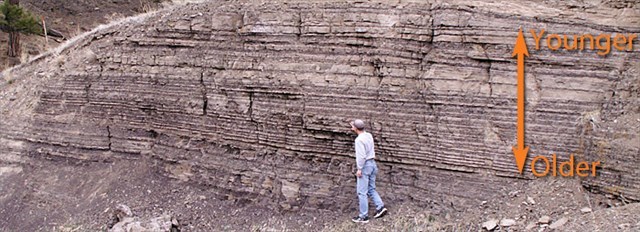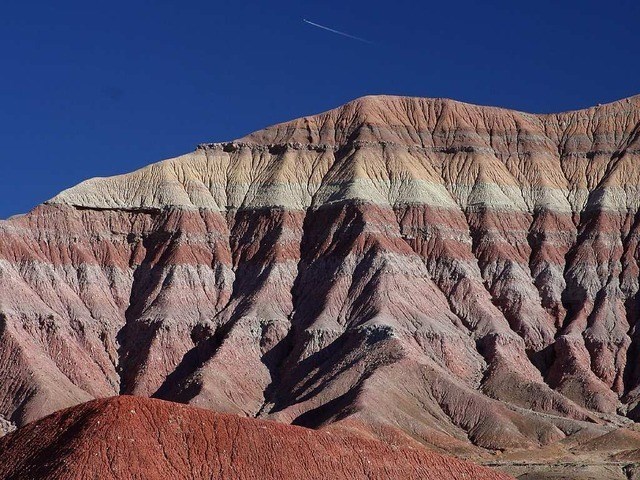
Catholic priest Nicholas Steno established the theoretical basis for stratigraphy when he introduced the law of superposition, the principle of original horizontality and the principle of lateral continuity in a 1669 work on the fossilization of organic remains in layers of sediment.
 Steno, in his Dissertationis prodromus of 1669 is credited with four of the defining principles of the science of stratigraphy:
Steno, in his Dissertationis prodromus of 1669 is credited with four of the defining principles of the science of stratigraphy:
- the law of superposition: "... at the time when any given stratum was being formed, all the matter resting upon it was fluid, and, therefore, at the time when the lower stratum was being formed, none of the upper strata existed";
- the principle of original horizontality: "Strata either perpendicular to the horizon or inclined to the horizon were at one time parallel to the horizon";
- the principle of lateral continuity: "Material forming any stratum were continuous over the surface of the Earth unless some other solid bodies stood in the way"; and
- the principle of cross-cutting relationships: "If a body or discontinuity cuts across a stratum, it must have formed after that stratum."
 These principles were applied and extended in 1772 by Jean-Baptiste L. Romé de l'Isle. Steno's ideas still form the basis of stratigraphy and were key in the development of James Hutton's theory of infinitely repeating cycles of seabed deposition, uplifting, erosion, and submersion.
These principles were applied and extended in 1772 by Jean-Baptiste L. Romé de l'Isle. Steno's ideas still form the basis of stratigraphy and were key in the development of James Hutton's theory of infinitely repeating cycles of seabed deposition, uplifting, erosion, and submersion.
Stratigraphy is a branch of geology concerned with the study of rock layers (strata) and layering (stratification). It is primarily used in the study of sedimentary and layered volcanic rocks. Stratigraphy has two related subfields: lithologic stratigraphy or lithostratigraphy, and biologic stratigraphy or biostratigraphy.
Lithostratigraphy - Variation in rock units, most obviously displayed as visible layering, is due to physical contrasts in rock type (lithology). This variation can occur vertically as layering (bedding), or laterally, and reflects changes in environments of deposition (known as facies change). These variations provide a lithostratigraphy or lithologic stratigraphy of the rock unit. Key concepts in stratigraphy involve understanding how certain geometric relationships between rock layers arise and what these geometries imply about their original depositional environment. The basic concept in stratigraphy, called the law of superposition, states: in an undeformed stratigraphic sequence, the oldest strata occur at the base of the sequence.
Biostratigraphy - Biostratigraphy or paleontologic stratigraphy is based on fossil evidence in the rock layers. Strata from widespread locations containing the same fossil fauna and flora are said to be correlatable in time. Biologic stratigraphy was based on William Smith's principle of faunal succession, which predated, and was one of the first and most powerful lines of evidence for, biological evolution. It provides strong evidence for the formation (speciation) and extinction of species. The geologic time scale was developed during the 19th century, based on the evidence of biologic stratigraphy and faunal succession. This timescale remained a relative scale until the development of radiometric dating, which gave it and the stratigraphy it was based on an absolute time framework, leading to the development of chronostratigraphy.
Chronostratigraphy - Chronostratigraphy is the branch of stratigraphy that places an absolute age, rather than a relative age on rock strata. The branch is concerned with deriving geochronological data for rock units, both directly and inferentially, so that a sequence of time-relative events that created the rocks formation can be derived. The ultimate aim of chronostratigraphy is to place dates on the sequence of deposition of all rocks within a geological region, and then to every region, and by extension to provide an entire geologic record of the Earth.
 A gap or missing strata in the geological record of an area is called a stratigraphic hiatus. This may be the result of a halt in the deposition of sediment.
A gap or missing strata in the geological record of an area is called a stratigraphic hiatus. This may be the result of a halt in the deposition of sediment.
The EC:
Q1 - In the rock face, how many strata can you count?
Q2 – Are they equally thick? Or does thickness vary?
Q3 – What is the average thickness of the strata.
Q4 – Are they all the same colour?
Q5 – Are they cross cut by any dykes (intrusions of darker rock)?
Note: Danger of falling! Slippery surfaces! Do not do this in stormy seas! Be carefull!

A Estratigrafia (do latim stratum e do grego graphia) é o ramo da geologia que estuda os estratos ou camadas de rochas, buscando determinar os processos e eventos que as formaram. Basicamente segue o princípio da sobreposição das camadas.
A Steno atribui-se definição da lei de sobreposição, e dos princípios de horizontalidade original, continuidade lateral: os três princípios básicos da estratigrafia. Nicolaus Steno foi um bispo católico dinamarquês e cientista pioneiro nos campos da anatomia e da geologia.
Litoestratigrafia: É a mais óbvia e a mais antiga das divisões da estratigrafia. Correlaciona os pacotes rochosos baseados na sua litologia, sem necessariamente se preocupar com o tempo de sua deposição ou formação. Ou seja, define a individualização dos pacotes rochosos, de outros pacotes, conforme suas características litológicas, composição mineralógica, granulometria ou mesmo cor. A unidade básica da litoestratigrafia é a formação geológica.
 Bioestratigrafia: Estuda as sucessões fossilíferas existentes nas rochas e sua correlação espacial. Estratos de diferentes localizações, com a mesma fauna ou flora são correlacionais em tempo. Está baseada no Princípio de sucessão faunística de William Smith;
Bioestratigrafia: Estuda as sucessões fossilíferas existentes nas rochas e sua correlação espacial. Estratos de diferentes localizações, com a mesma fauna ou flora são correlacionais em tempo. Está baseada no Princípio de sucessão faunística de William Smith;
Cronoestratigrafia: Estuda a idade relativa das rochas em relação às rochas circundantes;

A EC:
Q1 - No afloramento, quantos estratos podes contar?
Q2 - Eles são igualmente espessos? Ou a sua espessura varia?
Q3 - Qual é a espessura média dos estratos.
Q4 - São todos da mesma cor?
Q5 - São cortados por diques (intrusões de rocha mais escura)?
Nota: Perigo de queda! Superfícies escorregadias! Não faças esta cache com mau tempo! Cuidado!

 The most exciting way to learn about the Earth and its processes is to get into the outdoors and experience it first-hand. Visiting an Earthcache is a great outdoor activity the whole family can enjoy. An Earthcache is a special place that people can visit to learn about a unique geoscience feature or aspect of our Earth. Earthcaches include a set of educational notes and the details about where to find the location (latitude and longitude). Visitors to Earthcaches can see how our planet has been shaped by geological processes, how we manage the resources and how scientists gather evidence to learn about the Earth. To find out more click HERE.
The most exciting way to learn about the Earth and its processes is to get into the outdoors and experience it first-hand. Visiting an Earthcache is a great outdoor activity the whole family can enjoy. An Earthcache is a special place that people can visit to learn about a unique geoscience feature or aspect of our Earth. Earthcaches include a set of educational notes and the details about where to find the location (latitude and longitude). Visitors to Earthcaches can see how our planet has been shaped by geological processes, how we manage the resources and how scientists gather evidence to learn about the Earth. To find out more click HERE.